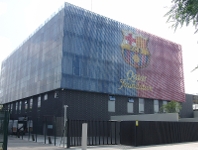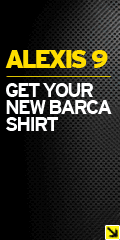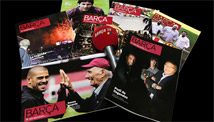A cinematic facade

Club
18.10.2011 10:26
350,500 leds for the facade of the Masia
www.fcbarcelona.cat
The latest technology and sustainability converge on the façade of the new Masia, which will be used as new advertising support by FC Barcelona sponsors. A 1,460 m² led screen will do this with no overheads for the Club.
The New Masia is more than a building and its façade is much more than a wall. It has set new
technological and financial standards for Spain. The 350,500 leds make the façade of the Oriol Tort
Training Centre into a 1,460m² giant screen where FC Barcelona sponsors and advertisers can
associate their image to the Masía and the inherent values of the Barça coaching system. The club
wanted to unite innovation and profitability in a project that has turned the facility into a new
way of promoting images. "We wanted to innovate once again and this time we have done so through
the New Masía. It has set global standards for sports training and we also want it to do so
architecturally and technologically and at the same use it for commercial purposes", explained the
Director for the Patrimonial Area, Jordi Moix.
A façade that associates values
Work, effort, fair play, leadership, understanding and companionship are some of the inherent values at Masía and the FC Barcelona training model. By implementing the new façade, sponsors and advertisers alike will be able to associate their name to the values of a world famous model. "The technology we use enables a diversified projection of the sponsors but can also be used by companies that want a unilateral association of their values to those of the Masía", says Antonio García-Valdecasas, president of the MCM Group, the company in charge of the overall execution of the project and the creators of the new facade.
Advertising and communication asset
The Board of Directors consider the geographical location and major visibility of the façade to be a "potential asset for commercial exploitation that can also be used to present messages from the club and its sponsors". There are no technological limits to the project, which offers a host of options for the display of contents. As well as advertising, the façade can also show live matches, scores or even symbols of festivities in the city, without the sponsors disappearing. These projections can be made without it interfering with the day to day life at La Masía in any way thanks to a dual-skin structure.
Economically sustainable model
 Sustainability was one of the core issues of concern in designing the Masía.
"Temporal, structural, aesthetic, environmental and especially economic sustainability”,
explains García-Valdecasas were the reasons guiding FC Barcelona’s decision to go for such a
unique façade, which Moix is convinced presents "many advantages and few inconveniences”.
Sustainability was one of the core issues of concern in designing the Masía.
"Temporal, structural, aesthetic, environmental and especially economic sustainability”,
explains García-Valdecasas were the reasons guiding FC Barcelona’s decision to go for such a
unique façade, which Moix is convinced presents "many advantages and few inconveniences”.
The key to the economic sustainability of the project is that "FCB has created a Masía that really cost much more than was paid because the MCM Group took charge of the additional construction and maintenance costs for the new façade with respect to the initial project and the switch to a system that also supported advertising. This formula is all part of the Board of Directors’ desire to obtain excellence, in this case architectonic, through financing that does not affect the ordinary resources of the club”. Antonio García-Valdecasas added that "a sustainable model like that of the Masía shall mark future constructions and will enable us to enjoy greater quality without the costs rocketing”.
Muro Cortina Modular Group, MCM
Muro Cortina Modular Group (MCM) is a Catalan company with thirty years of experience in the construction market. They are specialists in unique buildings and facades, and won the "Emporis 2010 Award" for the best skyscraper of the year, namely the Hotel Porta Fira in Barcelona by prestigious architect Toyo Ito. Rigor, innovation, environmental respect and research are some of the most prominent traits of this globally recognised company.
A façade that associates values
Work, effort, fair play, leadership, understanding and companionship are some of the inherent values at Masía and the FC Barcelona training model. By implementing the new façade, sponsors and advertisers alike will be able to associate their name to the values of a world famous model. "The technology we use enables a diversified projection of the sponsors but can also be used by companies that want a unilateral association of their values to those of the Masía", says Antonio García-Valdecasas, president of the MCM Group, the company in charge of the overall execution of the project and the creators of the new facade.
Advertising and communication asset
The Board of Directors consider the geographical location and major visibility of the façade to be a "potential asset for commercial exploitation that can also be used to present messages from the club and its sponsors". There are no technological limits to the project, which offers a host of options for the display of contents. As well as advertising, the façade can also show live matches, scores or even symbols of festivities in the city, without the sponsors disappearing. These projections can be made without it interfering with the day to day life at La Masía in any way thanks to a dual-skin structure.
Economically sustainable model
 Sustainability was one of the core issues of concern in designing the Masía.
"Temporal, structural, aesthetic, environmental and especially economic sustainability”,
explains García-Valdecasas were the reasons guiding FC Barcelona’s decision to go for such a
unique façade, which Moix is convinced presents "many advantages and few inconveniences”.
Sustainability was one of the core issues of concern in designing the Masía.
"Temporal, structural, aesthetic, environmental and especially economic sustainability”,
explains García-Valdecasas were the reasons guiding FC Barcelona’s decision to go for such a
unique façade, which Moix is convinced presents "many advantages and few inconveniences”.
The key to the economic sustainability of the project is that "FCB has created a Masía that really cost much more than was paid because the MCM Group took charge of the additional construction and maintenance costs for the new façade with respect to the initial project and the switch to a system that also supported advertising. This formula is all part of the Board of Directors’ desire to obtain excellence, in this case architectonic, through financing that does not affect the ordinary resources of the club”. Antonio García-Valdecasas added that "a sustainable model like that of the Masía shall mark future constructions and will enable us to enjoy greater quality without the costs rocketing”.
Muro Cortina Modular Group, MCM
Muro Cortina Modular Group (MCM) is a Catalan company with thirty years of experience in the construction market. They are specialists in unique buildings and facades, and won the "Emporis 2010 Award" for the best skyscraper of the year, namely the Hotel Porta Fira in Barcelona by prestigious architect Toyo Ito. Rigor, innovation, environmental respect and research are some of the most prominent traits of this globally recognised company.
Official sponsors
Copyright - FCBarcelona | Legal Terms | Buy tickets FC Barcelona | This is the FC Barcelona official website









